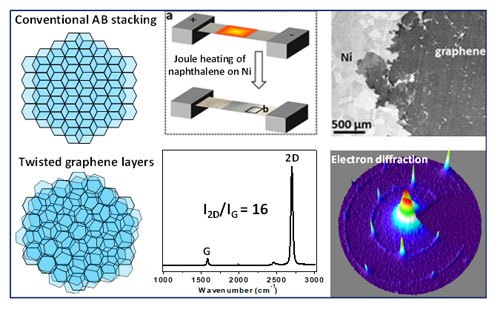 Graphene, the one-atom-thick sheet of carbon atoms, which is a boon for energy storage, coatings, sensors as well as superconductivity, is difficult to produce while retaining its single layered properties.
Graphene, the one-atom-thick sheet of carbon atoms, which is a boon for energy storage, coatings, sensors as well as superconductivity, is difficult to produce while retaining its single layered properties.
A new low-cost method of upscaling production of graphene while preserving its single layered properties, developed by Indian scientists, may reduce the cost of producing this thinnest, strongest and most conductive material in the world.
Researchers from Jawaharlal Nehru Centre for Advanced Scientific Research (JNCASR) an autonomous institute under the Department of Science & Technology, Government of India through their recent research work have upscaled graphene production while retaining its thin layered properties. This was made possible by a simple, affordable method wherein naphthalene coated nickel foil was heated for a few minutes in an ordinary vacuum by joule heating and was cooled to get twisted layers of graphene. Careful study using electronic diffraction and Raman scattering showed that the 2D single-crystal nature of the atomic lattice of the graphene is retained even in the multilayer stack. The twisted multilayer graphene that results is also highly conducting.
In the research by Nikita Gupta (Ph.D. student, JNCASR) and Prof. G.U. Kulkarni (corresponding author ) published in the ‘Journal of Physical Chemistry Letters’, the scientists have also defined a formula to quantify how much single layer like behaviour exists in such a system. The twisted system has multiple layers, each behaving like a single layer, allows variation in the experimental data within one sample, thus making quantification possible to achieve. The derived formula provides an insight into any twisted hexagonal multilayer system and may be used to tune superconductivity.
The researchers used a combination of two techniques to understand and quantify how much single layer like behaviour exists in the graphene system. Raman spectroscopy---a technique to understand whether a graphene species has single layer like behaviour arising because of no interlayer interaction and electron diffraction--a technique to study the morphology of the given twisted system.
Observing fascinating properties of twisted multilayer graphene such as visible absorption band, efficient corrosion resistance, temperature-dependent transport, influencing the crystalline orientation of source material, helped the JNCASR team to understand the landscape of the given twisted multilayer graphene system.
Recent publication in the journal ‘Nature’ by James M. Tour, an eminent peer on this research discovery (https://doi.org/10.1038/s41586-020-1938-0), confirms the upper limit of relative Raman intensity predicted by this work, experimentally. The present understanding of twisted multilayer graphene will help in understanding any twisted hexagonal system. It gives an upper limit of relative Raman intensity which can exist in a particular multilayer graphene system.
Publication link:
https://doi.org/10.1021/acs.jpclett.0c00582
For more details, contact Miss Nikita Gupta (Ph.D. student, JNCASR) nikitagupta[at]jncasr[dot]ac[dot]in; 9611151138 and Prof. G.U. Kulkarni (corresponding author) kulkarni[at]jncasr[dot]ac[dot]in; 9448825386.






























